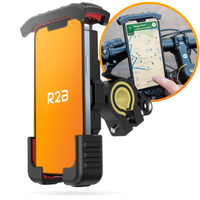No Products in the Cart

Replacing a bicycle saddle, how does it work? Discover it here!
Time to read 4 min
Time to read 4 min
In this blog article we will talk about replacing a bicycle saddle. We'll show you why it can be important to replace your saddle and discuss different options. We will then guide you step by step through the replacement process, including removing the old saddle and installing the new saddle. We also share useful tips for optimally adjusting your new saddle. So, if you want to improve your cycling experience and find the perfect saddle, you've come to the right place!
Replacing a bicycle saddle may differ per type of bicycle saddle, but the basics remain the same. Below is a general explanation about replacing a bicycle saddle.
Step 1: Gather the necessary tools
Make sure you have the right tools on hand before you start. You usually need an Allen wrench or an adjustable wrench to tighten or loosen the saddle bolts. Also check whether your new saddle comes with the necessary mounting materials, such as bolts and a clamp.
Step 2: Adjust the height of the new bicycle saddle
Before removing the old saddle, it is useful to adjust the height of the new saddle. This may vary depending on your personal preference and driving style. Measure the height of your old saddle and adjust the new saddle to the same height if necessary. This helps maintain a consistent feel while riding.
Step 3: Remove the old saddle
Use the Allen wrench or wrench to loosen the bolts or clamps that secure the saddle to the seat post. Be sure not to remove the bolts completely until you are ready to remove the saddle completely. Keep the bolts in a safe place so you can easily find them later.
Step 4: Attaching saddle to seat post
Take the new saddle and place it on the seat post. Make sure the saddle mounting points fit into the holes on the seat post. Align the saddle to the desired height and make sure it is straight. Gently slide the saddle forward or backward to find the ideal position.
Step 5: Attach the new saddle
Once the saddle is in the correct position, tighten the bolts or clamps securely. Start by manually tightening the bolts and then use the Allen wrench or wrench to tighten them securely. Make sure the saddle is secure and does not wobble.
Step 6: Check stability
After the new saddle is attached, it is important to check its stability before riding. Give the saddle a little wiggle and make sure it feels firm and secure. If there is any play or movement, tighten the bolts or clamps a little more.
Step 7: Test the new saddle
Now it's time to test the new saddle. Sit on the bike and take a short test ride to see if the saddle is comfortable and suits your body and riding style. Adjust the height or position of the saddle if necessary. Take the time to make sure you are happy with the new saddle installation before heading out on longer rides.
If you prefer to see how the bicycle saddle is replaced, you can click on the video below!
How often you need to replace your bicycle saddle depends on several factors. There is no fixed period for replacing a bicycle saddle. The lifespan of a saddle can vary based on use, the quality of the saddle and your personal preferences.
It is important to look for signs of wear, such as thinning padding or worn upholstery. Also, if you notice that the saddle is uncomfortable or no longer provides proper support, it may be time to replace it.
It is a personal choice and it is advisable to listen to your own body and consider a new one if you notice that the current saddle no longer meets your needs.
To replace a bicycle saddle you need some basic tools. Here is a list of the tools needed:
Allen wrench or adjustable wrench : You'll need an Allen wrench (also known as an Allen wrench set) to loosen or tighten the bolts that attach the saddle to the seat post. Alternatively, you can use an adjustable wrench if the bolts do not have an Allen head.
Possibly a torque wrench : If you have a torque wrench, you can use it to tighten the saddle bolts to the correct torque. This is especially useful if you have a carbon frame, as you need to be careful not to overtighten the bolts and damage the frame.
It can also be helpful to have a cloth on hand to clean the saddle or remove any excess grease during the installation process.
Most bicycle saddles are supplied with the necessary mounting materials, such as bolts and a clamp. Always check the instructions that come with the new saddle to ensure you have the correct mounting hardware.
The R2B bicycle saddle is specially designed for both women and men and contains reflective elements for improved visibility while cycling. The saddle comes with a waterproof saddle cover, which keeps the saddle protected against rain and dirt.
The ergonomic design provides comfort and support, while the reflective details contribute to a safer cycling experience, especially in low light. The R2B bicycle saddle is ideal for anyone looking for a saddle with visibility features and protection against the elements.
View the R2B bicycle saddle here


